| Imperial Crownlands of Greater Hulstria Die Kaiserlichen Kronenländer Größeren Hulsterreichs | |||||
|---|---|---|---|---|---|
| |||||
  Flag Coat of Arms Flag Coat of Arms
| |||||
| Anthem For the Monarchy | |||||

| |||||
| Capital Kien | |||||
| Languages Hulstrian, Kunikata | |||||
| Demonym Greater Hulstrian | |||||
| Government Constitutional Monarchy, Parliamentary Democracy Emperor of Hulstria First Ferdinand I Last Klaus Gustav VI First Last | |||||
| Legislature Imperial Diet | |||||
| Area 855,600 km² | |||||
| Population 99,687,215 (3149) | |||||
| Currency Hulstrian Crown (Hulsterreichischer Krone - ₭) | |||||
Greater Hulstria, officially the Imperial Crownlands of Greater Hulstria (Hulstrian: Die Kaiserlichen Kronenländer Größeren Hulsterreichs) was the longest-lasting regime governing what is know known as Mikuni-Hulstria, having existed for nearly a millennium. Greater Hulstria was a constitutional monarchy with the Emperor of Hulstria of the House of Rothingren-Traugott reigning as the hereditary and ceremonial Head of State. Greater Hulstria had an elected Head of State called the Governor-General of Greater Hulstria which represented the Monarchy in political affairs; this system made the Hulstrian government very unique in its structure and one of the few constitutional monarchies on Terra to have such a system. The Staatsminister of His Imperial Majesty's Government was the Head of His Imperial Majesty's Government and headed the cabinet, as well as the national parliament, called the "Imperial Diet", comprising of currently 725 representatives. Greater Hulstria was also, at various times in its history, in personal union with other monarchies, including Luthori, Trigunia, or Dolgaria.
History[]
2nd Imperial Crownlands of Greater Hulstria[]
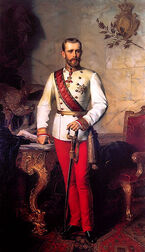
Ferdinand I, the first Emperor of the 2nd Imperial Crownlands.
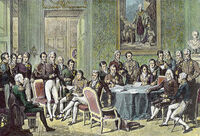
The Congress of Kein, between the KHP and PRP, votes to restore the Monarchy
Following the collapse of the Aneist Unionist Party, the KHP and PRP agreed to reestablish the Hulstrian Monarchy. As plans for the restoration of the Monarchy were being made the United Democrats reappeared and agreed to support the Monarchy as well. On August 3, 2551 the Monarchy was restored in Hulstria, with all parties with and without seats voting yes, even though the PRP was officially remained a republican party. Following the restoration of the monarchy under Ferdinand I, son of the last Hulstrian Emperor during the period of Duel Monarchy, Rudolph IV, the Imperial Diet saw an influx of small regional level parties who called for increased independence for the individual and greater power to local governments. This period also saw the resurgence of the atheists, now as the Aneist Patriciate Coalition. On March 17, 2560, Kaiser Ferdinand I passed away having reigning only for 9 years and he was succeeded to the throne by his son, Klemens II. Klemens's reign marked a period of stuanch royalism in the Imperial Diet, with no lesser then 7 royalist parties holding seats in the legislature. Within the Monarchy his reign was defined by his staunch reactionaryism. All marriages of his children and grandchildren were carefully overseen, ensuring that they married with in proper levels of nobility, a policy which still continues today. The reign of Klemens II was also defined internationally by the War of Luthori Succession, in which the sitting Monarchy of Luthori was ousted by Republican forces. The Luthori Emperor, William III, was supported by his son-in-law, Philippe II of Alduria and several other Monarchist throughout Terra. Hulstria originally entered the war when it was promised Klemens II would be recognized as the rightful Luthori Emperor however this was not to be the case and Klemens was eventually forced to support the claim of his rival Mary of Orange or see a Republic continue in Luthor. Klemens was once again promised in the throne during a dispute between the Protestant and Catholic royal houses of Luthor, however once again this promise fell through. The end of Klemens's reign was fairly uneventful and when he died he was succeeded to the throne by his son, Godric I. Godric's reign saw little in the realm of policy shifts within the government. The Progressive Liberal Party of Hulstria continued to dominate the office of Lord Protector until October of 2602 when the first female Lord Protector, Millicent Maire von Scharnhorst, assumed the office. Four years later while being driven home from Schloss Phönixstein, Godric was tragically killed when his driver lost control of the limousine while driving on an icy road. The limousine crashed into a tree killing both the Emperor and his driver on impact. His only son, Rudolph, was crowned Rudolph V, Emperor of Hulstria and succeeded him. Shortly after Rudolph's succession to the Hulstrian throne, the country reverted back to a traditional constitutional monarchy abolishing the position of Lord Protector and leaving the Head of State fully hereditary in 2607.
The Iconic Monarchy[]
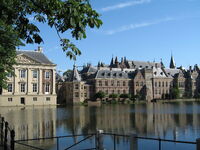
The Imperial Diet, Hulstria's National Legislature
The reign of Rudolph V saw the beginning of a new period in Hulstrian Politics. Increasingly many parties of the Imperial Diet began to set aside the ideological extremist bickering in favor of truly intellectual debate. Internationally Greater Hulstria rose to a position of great prominence, being called the "paragon of the modern Monarchy" by international observers. Rudolph's marriage to Empress Josephine I of Luthor signaled the beginning of preeminence of the House of Rothingren-Traugott and unification between the two Monarchs, with the couple's child to reign over both Hulstria and Luthori. This period internationally however was that of an unstable one; it saw the rise of both the New World Order and the Kennedy Junta in Jelbania and Deltaria, bringing about instability throughout western Terra. Tragically Rudolph V was assassinated on 14 August, 2648 along with the chairman of the Imperial Hulstrian Party in honoring the first election of the Governor-General of Greater Hulstria, Karl van Gessel. The perpetrators were never identified or caught, however, with the fall of the Kennedy Junta years later, the Hulstrian government has implied it believes they were behind it. His son Heinrich I came to the throne, assuming Head of State titles in both Hulstria and Luthori, uniting the countries in personal union for the first time. Heinrich's reign was marked by relative peace, with the exception of the Republican take over of New Komeito Party. This period saw the end of the direct involvement of the Monarchy in the legislature with the dissolution of the KHP, the monarchy's advocates in the Diet though remained defended by other parties. International, Heinrich became one of the most powerful men on Terra (nicknamed the "Universal Emperor") holding the thrones of Alduria, Luthor, and Trigunia in personal union with Hulstria.
Heinrich I, after ruling for over 67 years, died in Kien in 2714 at the age of 103 as one of the oldest and longest serving Monarchs in Greater Hulstria; Heinrich’s grandson, Konstantin, and son, Gustavus, were given their own thrones, spliting Heinrich’s universal empire into two. However, the thrones remained under the Rothingren-Traugott dynasty. Konstantin assumed the thrones in Hulstria and Trigunia as Heinrich II of the senior line of the Rothingren-Traugotts and Gustavus assumed the thrones in Luthori and Alduria as Gustavus I of the Orange-Villyan cadet branch of the Rothingren-Traugotts. Unlike Gustavus, Konstantin was not the son of Heinrich I yet was rather his grandson; after Crown Prince Leopold, the twin brother of Gustavus, died of lung canger at the age of 83, Konstantin took his place in the line of succession and became the new Crown Prince. Gustavus himself was fairly older when he become Holy Luthori Emperor and he only ruled for 12 years, passing away at the age of 95 in 2726. Heinrich II ruled for over 33 years; little or no republican activity took place within the country, contrary to the activity saw under his grandfather’s reign with the Revolutionary Republican Army. This fact was attributed to the large influence of royalist and conservative parties in the Imperial Diet; the Hulstrian electorate remained with conservative political parties and parties like the Conservative Voice, Fascist Authority, and Imperial Hulstrians were the three dominant parties, often making the majority of national policy together. This dominance was called the “Imperial Conservative Era”, which these three parties were in a united cabinet in the Imperial Conservative coalition, where the name of the period came from. Major leaders during this time were Edmund von Greifstien, Gregory Klineman, and Hildegard Klay.
With concerns to Foreign policy, Hulstria rose to great prominence; in the New Englian Crisis, Hulstrian Governor-General Wolfgang Reinhardt successfully negociated a peace between Kirlawa and Kazulia in the “Treaty of New Indrala”, creating a joint government over the territory of New Englia between Hulstria, Kirlawa, Sekowo, and Kazulia. This agreement ended conflicting claims to the territory and the heated tensions between the Kirlawan and Kazulian government; Reinhardt would later on go to win an international peace prize in 2720 for his mediation efforts.
Government & Politics[]
The Imperial Crownlands of Greater Hulstria was a constitutional monarchy, in where the Emperor of Hulstria (Hulstrian: Kaiser) was the hereditary and imperial Head of State who possessed ceremonial and other executive powers; tradition held that the Emperor maintain neutrality in partisan political matters, acting as a symbol of unity, and defender of the Hulstrian people. Upon the death of the sitting Emperor his closest living heir assumed the throne as per the Writ on the Regulation on the line of succession to the Hulstrian throne. The Governor-General of Greater Hulstria was the elected Head of State and acted as the representative of the Monarchy in political affairs. The Staatsminister of His Imperial Majesty's Government was the Head of Government in Greater Hulstria; the Staatsminister chaired the cabinet and could call emergency cabinet sessions or call for a new cabinet in time of crisis, among other powers. All offices held their own unique powers within the nation. For example the Emperor of Hulstria had the power to nominate an "Imperial Commissioner for the Eastern Territories", the administrative head of Hulstria's empire; such a nomination needed to be confirmed in the Imperial Diet.
The nation was divided into five regions, called Crownlands, headed by a Chief Minister and governed by their own respective legislature, called "Landtags", and own set of laws, but most power rested with the Imperial Diet in Kien. Elections for Chief Minister and Landtags were held every three years, concurrent with the national elections for Governor-General and for the Imperial Diet. Cities and towns had their own Mayors and local governments; the Kaiser could appoint Imperial Mayors to act as a royal representative of the monarch in a town or city of his picking; each Crownland as well had a Crown Commissioner that was soley appointed by the Monarchy and the Crowm Commissioner was the monarch's representative in, mainly, regional judicial affairs. The Imperial Diet was the national legislature of the Imperial Crownlands of Greater Hulstria and consisted of over 725 representatives from across the country. The Imperial Diet was located in Kien and the head of the Imperial Diet was the Staatsminister who also chaired the cabinet.
Demographics[]
Religion[]
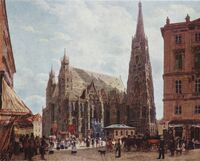
The Hulstrian National Cathedral, Kien
Stats on Religion of all nationals:
- 78% Hosian
- 63% Luthoran
- 19% Bishopal
- 10% Selucian Patriarchal
- 2% Mormon
- 6% Other
- 15% Gao-Showan religions
- 6% Atheist/Agnostic
- 1% Other
By Greater Hulstrian law the the official religion was Lutheranism, however the Hulstrian population was free to worship as they wished and hold membership in whatever religion they liked.
Ethnicity[]
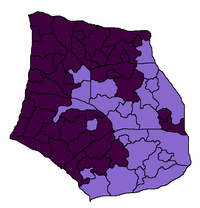
The Districts of Hulstria by Ethnicity during the Dual Monarchy

The Districts of Greater Hulstria by ethnicity
The population of Greater Hulstria was largely divided into two groups. The Caucasian Hulstrians were the descendants of Luthori and other Artanian colonists to the nation, were largely Hosian/Luthoran, and lived mostly in the North and West of the country. The Gao-Showa were considered the native population, although they also colonised the nation, roughly one millennium before the Hulstrians. They were mostly followers of Kamism and Daenism and lived in the East and South. The division between these groups and the rival claims to ownership of the country often led to rivalry and war between the two. There were other ethnic groups present in the nation, notably the Draddwyr who came to Hulstria during the Draddwyr Genocide in Dranland, but also Kazulians, Dranians, Sekowans, and Trigunians. Most immigrant populations were quickly subsumed into one of the main ethnic groups.
